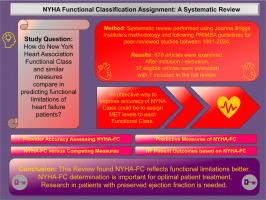与其他指标相比,纽约心脏协会功能分类的效用:一项系统综述
引用次数: 0
摘要
该系统综述包括对与纽约心脏协会功能分类最相似的相关文献的评估。此外,我们评估了在分配心力衰竭患者的功能类别时,这些测量是否与纽约心脏协会功能分类的准确性相比较。该综述包括7篇符合纳入和排除标准的文章。我们的研究结果是,与其他指标相比,纽约心脏协会功能分级可预测射血分数降低的心力衰竭患者的功能限制。然而,支持纽约心脏协会功能分级对保留射血分数的心力衰竭患者的预测能力的证据有限。提高纽约心脏协会功能分类准确性的一种更客观的方法可能是为每个功能类别分配代谢当量水平。对于未来的方向,需要一个与相关症状相一致的清晰客观的功能分类定义,以确保分配的一致性。此外,纽约心脏协会功能分类在保留射血分数的心力衰竭患者中的进一步测试具有可重复性是有必要的。本文章由计算机程序翻译,如有差异,请以英文原文为准。

Utility of the New York heart association functional classification compared to other measures: A systematic review
This systematic review comprised of an assessment of the relevant literature for measures that were most similar to the New York Heart Association Functional Classification. Additionally, we assessed whether those measures compared in accuracy with the New York Heart Association Functional Classification when assigning the functional class of patients with heart failure. The review included seven articles that met the inclusion and exclusion criteria. Our findings were that New York Heart Association Functional Classification was predictive of functional limitations in patients with heart failure with reduced ejection fraction when compared to other measures. However, there was limited evidence to support the predictive ability of New York Heart Association Functional Classification in patients with heart failure with preserved ejection fraction. A more objective way to improve accuracy of New York Heart Association Functional Classification could be to assign metabolic equivalent levels to each functional class.
For future directions, a clear objective definition of functional class that is in alignment with the associated symptoms is needed to ensure consistent assignment. In addition, further testing of the New York Heart Association Functional Classification in patients with heart failure with preserved ejection fraction with reproducibility is warranted.
求助全文
通过发布文献求助,成功后即可免费获取论文全文。
去求助
来源期刊

Health sciences review (Oxford, England)
Medicine and Dentistry (General)
自引率
0.00%
发文量
0
审稿时长
75 days
 求助内容:
求助内容: 应助结果提醒方式:
应助结果提醒方式:


